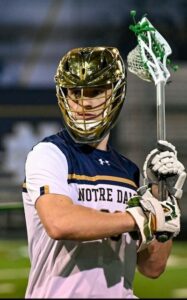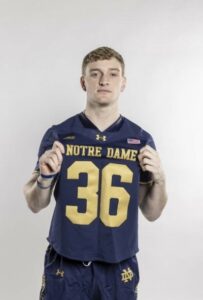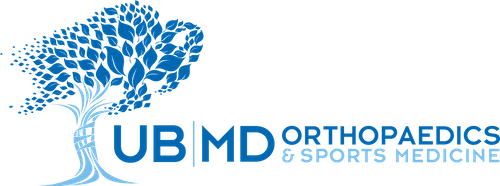“I want to express my gratitude for Dr. Wind and his staff, with the whole process and how considerate and how caring they were of my situation and helping me through the whole process.”
Jeremy Hopsicker is a 20-year-old impassioned lacrosse player who lives with his parents and sister in Brockport, NY, a tight-knit community just outside Rochester. “Both my parents were college athletes, so I kind of followed in their path,” says Jeremy.
“I’ve actually been playing lacrosse since kindergarten,” he proudly admits.
In 2020, Jeremy arrived back in Brockport after attending a Connecticut boarding school where he had played lacrosse, a mere two weeks after receiving his acceptance letter to the University of Notre Dame to play for the university’s lacrosse team.
At the time, however, he also began experiencing major swelling in his right knee and immediately sought the opinion of an athletic trainer, who advised that he get it further checked by an orthopaedic specialist.
A family friend in Albany, himself an orthopaedic surgeon, recommended that he make an appointment to see Dr. William Wind, an orthopaedic surgeon with UBMD Orthopaedics & Sports Medicine. Dr. Wind initially diagnosed Jeremy as having an OC (osteochondral) lesion on both sides of his right knee. This is a disorder of the cartilage and bone of the knee and causes pain in the knee joint.
From the very first visit, Dr. Wind and Jeremy talked about his options and decided early on that the best strategy for treatment was to have the cartilage in his knee restored through knee surgery, and the sooner the better. The doctor told Jeremy that he was going to perform an allograft transplantation, perhaps overwhelming Jeremy a bit when describing his anticipated surgery.
Says Jeremy about his anxiety, “The best thing I got was his honesty throughout the whole process. He told me he would need to see inside the actual knee to determine the amount of damage and that he had different plans for each situation he might find. So, I was confident in his abilities and whatever situation he found.”
Jeremy continued emphatically, “I really trusted him through the surgery and after . . . he gave me a course of action and wrote me scripts for my PT and everything else to keep me moving along.”
Fulfilling the dream . . . Saving a knee for a young athlete
More than one-third of Americans report being impacted by knee pain. Knee replacement surgery can offer relief, but the implants only last between 12 and 15 years. Patients under age 40 typically are not judged as good candidates for knee replacement surgery because they would need to have the surgery revised. Now, however, there’s a much simpler procedure that’s saving knees in younger patients.
Osteochondral allograft transplantation allows damaged cartilage tissue to be replaced with new, healthy tissue of bone and cartilage, donated from a tissue bank or cadaver. The cartilage cells survive the transplantation process if the tissue is “fresh” or has not been frozen or subjected to radiation. The graft is taken as a cylindrical plug of cartilage and bone and is placed into the damaged area, restoring a smooth cartilage surface. The allograft may be then shaped explicitly for the patient.
Repair of human cartilage is one of the greatest challenges in orthopaedic medicine. Fortunately, among Dr. Wind’s specialties is cartilage injuries with a particular interest in cartilage restoration in the knee. “My main focus of practice is care of rotator cuff tears and instability of the shoulder, as well as knee ACL tears and cartilage injuries. I have a particular interest in cartilage restoration in the knee, which involves cartilage transplant to preserve the native knee joint,” says Dr. Wind.
Dr. Wind’s additional responsibilities include being the assistant team physician for both the Buffalo Bills and Buffalo Sabres. He also is the head team physician/orthopedic surgeon for the University of Buffalo and Niagara University.
Unfortunately, the doctor was unable to perform the necessary procedure for several months since the allograft transplantation required that healthy cartilage tissue had to be taken from a donor. Consequently, Jeremy had to be placed on a donor list and wait for the healthy cartilage tissue.
Once the tissue was secured, however, they encountered another hitch. It was the height of the Covid pandemic, so many surgeries were being postponed.
Finally, on November 24, 2020, Dr. Wind was able to successfully perform the allograft transplantation procedure.
Getting stronger, getting the right knee on par with the left
“Of course, there was a lot of uncertainty about the procedure. You never know how the surgery is going to turn out, especially after an allograft procedure. Your body has to accept the transplant and they have to make sure it fits right and aligns perfectly with the other parts of your knee,” reveals Jeremy.
A month after the surgery, it became quite apparent Jeremy’s body had accepted the transplant, so he proceeded to the next step — getting stronger, getting the right knee back on par with the left knee. Rather than drive back to Buffalo, however, he opted to do his physical therapy at a Greece, NY facility, an hour’s drive from his home.
However, Jeremy did re-visit UMBD Orthopaedics & Sports Medicine several times, where Dr. Wind personally met him each visit. “I met with Dr. Wind every time I came into the office. I think I ended up, from my initial appointment to my last follow-up this past summer, visiting with him over six times.”
The first few days after the procedure were especially tough, says Jeremy, but he bore down and each day, he saw progress, with his knee getting stronger and stronger, along with an enhanced mobility.
During his recovery, Jeremy began his college career at Notre Dame where he continued to perform numerous single leg strength exercise, especially with a leg press. Physical therapists at the university discovered that Jeremy’s right leg still had a significant strength deficit, so they also devised a plan to get the leg back to full strength.
When asked what he’d say to anyone dealing with a knee injury, Jeremy responded, “The number one thing is do the physical therapy. It’s huge and if you don’t, I’ve heard stories of persons who have had recurring injuries from not doing the physical therapy properly. I think that’s the biggest thing. Take it one day at a time.”
Excited to realize his dream of playing lacrosse at Notre Dame
Today, Jeremy is attending Notre Dame, majoring in Finance, where he is a full-fledged member of Notre Dame’s lacrosse team, able to fully participate in their matches.
At first, being off the lacrosse field for the better part of two years, he was a bit rusty, lacking in both game shape and game speed. However, he vividly recalls his first game. “I remember the first game back. It was one of the better days of my life. It was just awesome to be able to go back out there and play again,” recounts Jeremy.


